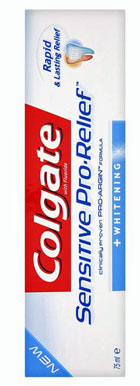 Ingredients
Ingredients- Arginine (bicarbonate)
- Calcium carbonate
- Aqua (water)
- Sorbitol
- Sodium lauryl sulfate
- Sodium monofluorophosphate
- Aroma
- Sodium silicate
- Cellulose gum
- Titanium dioxide
- Potassium acesulfame
- Xanthan gum
- Sucralose
Published May 2010
This makes the claim that it provides "freedom to forget about the pain of sensitive teeth" and its active ingredients suggest that it really does work. Tooth enamel can be attacked by the acids produced by bacteria in the mouth as they feed on sugar. It then develops tiny holes which give access to the pulp cavity and its nerves so that hot and cold things cause pain. As the gums recede with age this exposes more of the tooth not protected by enamel. Colgate toothpaste plugs the holes and gaps.
Ingredients
Active ingredients
A combination of arginine with calcium carbonate can repair tooth enamel. The arginine activates bacteria which neutralise the acids produced by other bacteria, while the calcium, along with saliva, restores the enamel. Arginine (as bicarbonate) is an amino acid, and a component of proteins, and peanut protein contains a lot. Arginine is reputed to help wound healing, and it also makes the NO messenger molecule which triggers erections. Calcium carbonate ( chemical formula CaCO3) occurs naturally as limestone, marble, and egg shells. Here it is the industrially produced pure form (E170). Calcium carbonate is also used as a filler in plastics like PVC. Ground-up calcium carbonate makes an excellent scouring powder which does not scratch surfaces.
Sodium monofluorophosphate (chemical formula NaFPO3) provides the fluoride to strengthen the tooth enamel by converting the calcium phosphate hydroxide of which it is made to calcium phosphate fluoride which is tougher and acid resistant.
Sodium silicate (aka water glass, chemical formula Na2SiO3) is an adhesives and used to heal wounds. It can also be used as an emergency repair paste for sealing leaks in car exhausts.
Sweeteners
These are potassium acesulfame (aka E950) which is an artificial sweetener consisting of a ring molecule with sulphur and nitrogen atoms, and sucralose (aka Splenda, E955) which is an artificial sweeter made from sugar to which three chlorine atoms have been attached. This makes it impossible for enzymes to break it down into acids. Sucralose has a long shelf life. When potassium acesulfame and sucralose are used together each reinforces the effect of the other so very little of either is needed.
Cleaning agent
Sodium lauryl sulfate is a foaming surfactant that lifts dirt and grease off the teeth.
Other ingredients
Sorbitol keeps the toothpaste moist and viscous. It is a sweet tasting sugar alcohol and it is particularly abundant in pears. It is manufactured on an industrial scale from glucose and hydrogen. It is used as a sugar substitute but, unlike sugar, it does not cause tooth decay.
Xanthan gum (aka E415) holds all the other ingredients together as a homogeneous paste.
Cellulose gum (aka E466) is a thickening agent used in many products from detergent gels to lubricating jelly. Here it is the food grade quality and it gives the toothpaste the desired texture.
Titanium dioxide (aka E171) is an intensely white pigment.